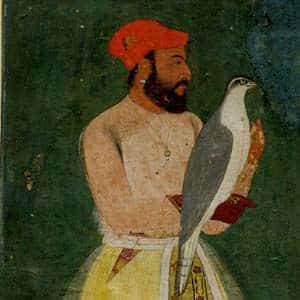The Guru's Baaz
People of Punjab are largely ignorant about the Eastern (now Northern) Goshawk, which was the falconry or hunting bird of Guru Gobind Singh. Though it has been declared the state bird, the goshawk is not known to migrate to Punjab from the higher Himalayas and efforts by the state government to breed it in captivity have not fructified. By Vikram Jit Singh


The father of Indian ornithology, TC Jerdon, wrote in 1862 that the female goshawk (which is larger than the male) would sell for a princely sum. The female was called the 'baaz' while the male was called 'jurra'. Jerdon's take: "The baaz is the most highly esteemed bird of prey in India and a trained bird used to be sold for a large sum in former days...for prices varying from Rs 20 to Rs 50 for the female and from Rs 10 to Rs 30 for the male". A Mughal courtier with a N. goshawk, 1620. Photo: British Museum
India's specialist on birds of prey, Rishad Naoroji, wrote of the goshawk's hunting skills thus: "The goshawk was considered noble and its prowess in falconry highly-esteemed. Its name also pertains to an era when only the nobility could fly this species. Reckless in pursuit, it focuses on its quarry regardless of natural or man-made obstacles. It is this feature that has made it a favourite among falconers. The powerful female was traditionally trained in Punjab to take large prey such as hare, Macqueen's bustard, crows, owls, herons, ducks, geese, and even cranes and large game birds such as partridges, junglefowl, pheasants, in Sind even gazelles.'' India's quintessential birdman, Dr Salim Ali, vouched for the goshawk, saying: "Highly prized by falconers, and was in great demand when falconry was more popular in West Pakistan and India."
BLOODY ROYALS!
In the week that has passed are embedded the birthdays of two men instrumental in converting the Keoladeo Ghana Jheel (lake) in Bharatpur, Rajasthan, from the most infamous mass duck-shooting site to a fabled preserve of migratory and resident birds. The late Dr Salim Ali (born November 12, 1896), who led the march of conservationists into the lake, and then Prime Minister Jawaharlal Nehru (November 14, 1889) who on Dr Ali's call in the 1950s saved the wetland from being reclaimed and converted into agrarian holdings. Though Dr Ali started off his odyssey into the world of birds by shooting down a rare sparrow
He wittily describes in his celebrated autobiography the massacres organised by Bharatpur's Jaat royalty, who enjoyed private shooting rights well after Independence. In one such shoot, Dr Ali recounts the travails of the then viceroy, Lord Marquess VAJH Linlithgow, who fired 1,900 rounds of .12 bore ammunition on November 12, 1938, and did not have much to show for it except bruised shoulders and ego. "Enormous holocausts were `accomplished' at some of these gargantuan shoots, and there are several records of 2,000-3,000 birds being killed in a single day, and three records even of over 4,000. The all-time record of 4,273 ducks and geese to 38 guns was made in November 1938, with Lord Linlithgow as the presiding slayer. Although the lord sahib's own contribution to the bag was not impressive, he did distinguish himself by creating what surely must be a world record, of firing 1,900 rounds from his own shoulder on that day. Only one who has let off even a paltry hundred shots in a morning's snipe shoot and got his shoulder black and blue will appreciate the magnitude of this almost superhuman performance, even after making due allowance for his lordship's considerable weight and substance''.
NOT NOW, HONEY
Just outside our house is a park where a hive of honey bees had peaceably parked themselves. But that irrepressible slayer of bees, the Oriental Honey-buzzard, decided to savour some "honey and toast" as the chill advanced! The buzzard dashed against the hive, flapping wings and making whistling calls, sparking off a mob of irate bees that set upon on our neighbourhood dhobi, Ramesh Kumar, and his well-heeled customers waiting patiently for him to iron a crisp saree for a wedding reception. The buzzard itself was unmoved as it is armoured with dense, scaly feathers to ward off stings, including the lores (area between its eyes and nostrils). It relishes bees, larvae, honey and combs. Ramesh and two of his customers had to dive into the former's tented shack till the bees subsided.
Though Ramesh is nature-friendly and puts out water for birds in hot summer, he was exasperated. Fearing customer withdrawal symptoms, Ramesh requested me to call the municipal corporation and have the hive destroyed. Only great persuasion dissuaded the gentle Ramesh from his mission of dispensing with the hive. Young couples who make out in the park where the tree is situated were doomed. Eight of these youngsters were stung just as things were starting to warm up behind the bushes under the tree. The angry bees did have their admirers, too, for these stinging creatures relieved the pressure on the lungs of the nearby electricity department sub-station staffers, who idle their time by heckling lovebirds indulging in immoral frolic. The buzzard would launch his kamikaze dives into the hive just after noon and again before sundown for an early supper. As bees swarmed and stung lovers prompting all kinds of unimaginable "oohs and aahs", the buzzard would hardly raise an eyebrow while sitting on an adjoining branch, sampling his food like a savant Scotch taster.



